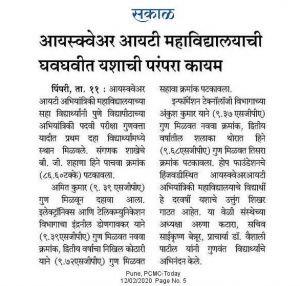

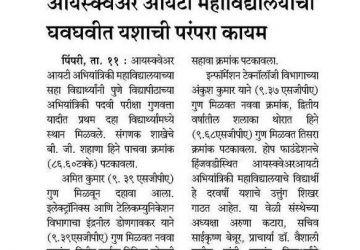
Yoga is a science and a discipline that has been handed down to us by seers and mystics who developed techniques to enhance our physical and mental agility. It is said that the practice of Yoga brings flexibility to the spine and joints, keeps the muscles of the body pliable and youthful, increases circulation of blood and strengthens our internal organs; Yoga is all this and more. Yoga improves the power of concentration, cures constipation, relieves stomach disorders, improves coordination of muscles and reduces body fat, strengthens the mind-body connection, calms and relaxes the mind, enhances self-confidence, strengthens self-discipline and self-resolve, reduces stress and increases vitality and energy throughout the body – in fact it can be presumed that NO other form of known exercise can provide all these benefits at one go. Hence, it would appear that yoga has extensive benefits and can help us to be more balanced, relaxed, focused, efficient and effective – professionally and personally.
In today’s competitive professional world physical fitness can be directly proportional to an individual’s and team’s performances. Technological developments have reduced effort which has impacted people’s physical and mental ability. People are willing to invest in developing professional skills towards advancing one’s career but it is crucial that one needs to support that will a healthy body that is flexible, strong and controlled. In ability to move one’s body with dexterity performances will be lacklustre. Similarly, if one is not able to maintain endurance or stamina for a considerable duration of time, the performance will be diminished. In order to be successful, it is also necessary that a person stays focussed and concentrate with confidence on the task without distraction. Dealing with distractions, adversity and stress is an important component of everybody’s life. So, how can yoga assist in strengthening the mind and body of a person and help him/her perform his/her best?
Yoga is the application of physical postures, control of breath, purification and relaxation of mind body and spiritual principles aimed at bringing greater unity and balance to the mind and body. Yoga teaches a person how to link the mind and body and to come into the present. The breathing techniques in pranayama helps a person to focus on breath, calm the mind and build concentration ability.
Yoga asanas also help to develop the control and concentration of the mind. Being able to hold a posture with steadiness, relaxation and comfort requires that a person is able to focus their mind for an extended period of time. This leads to developing strength and concentration in mind / body and is beneficial to be alert and fit even in competitive scenarios.
Asanas also help to create harmony and balance between the mind and body and help to achieve a healthy body and stable mind, It is all about controlling the mind through physical discipline. Asana aid the efficient functioning of internal organs this leads to an overall positive effect on our body. Yoga Asanas are designed to keep the proper curvature of the spine and to increase its flexibility, develop the function of the cerebellum, the brain centre that controls the body when in motion, improve muscle coordination which improves the grace and fluidity.
YOGA IS FOR EVERYONE. Yoga works on strength, flexibility, balance, agility, endurance, core, and overall strength, among other things. Anybody can benefit hugely by adding yoga to his / her daily regimen. Here’s how Yoga can enhance your life…
Strength: consistently holding up your own body weight will give you more strength than lifting weights
Flexibility: Regular practice of yoga increases flexibility and ease of movement, therefore increasing range of motion. In particular, athletes in sports that require swinging action (tennis, golf, etc.) can benefit greatly. Flexibility in general also helps to prevent injury.
Balance: yoga improves overall balance in everything you do, preventing falls and injury. When you learn how to be soft and go with the flow, you can easily bend more and are less likely to break or fall over.
Endurance: yoga gives you the endurance. When you learn to tune into your body and mind, any profession can be a form of meditation. Yoga teaches how to pace yourself, slow and steady, for the long haul.
Core: Every asana and pranayama in yoga works on your core strength. Strong core is essential for a healthy back and a healthy body.
Stability: Yoga helps strengthen and stabilize the little muscles that other forms of physical workouts miss and are important in protecting your joints and spine.
Recovery: Yoga also helps bounce back after injuries or ailments by tuning into your body and nurturing it with the care it wants and needs.
Most importantly, yoga changes the way you breathe, walk, think and approach everything in life: Your nimbleness with help you build confidence, help you perform better in a professional world and thereby make you successful. Your body will work in tandem with your mind, increasing your flexibility and performance all around.
To all the youngsters, I say, now is the time to set aside just 30 minutes a day and indulge in this ancient form of exercise that can have life-altering benefits for the rest of your lives!
The author of this blog article is Madhuri Reddy, Assistant Professor,Department of Engineering Sciences, International Institute of Information Technology, (I²IT), Pune (www.isquareit.edu.in) (madhurir@isquareit.edu.in)
January 22, 2020
Space weather which is governed by solar activities is the key cause of Sun-Earth interaction system. The Sun-Earth interaction significantly affects the magnetosphere- ionosphere- thermosphere system leading to diverse physical phenomena. The earth’s ionosphere is highly affected with the space weather events such as Coronal mass ejections, geomagnetic storms, solar winds and solar flares. The earth’s ionospheric parameters such as electron density, total electron content (TEC), electron and ion temperature behaves in a varied fashion to the incoming solar flux, electrodynamic drift, which makes its prediction very complicated. These parameters are found to be varying with local time, season, latitude, longitude, solar activity and with the conditions on sun and earth’s magnetic field.
Recent increase in solar activities has resulted in an increased concern of the space weather community. These solar activities can lead to the major catastrophic events. It has been proven that every 11 years or so, the solar activities reaches to a peak; this phenomenon is referred to as solar cycle. And peak observed during these solar cycles is termed as ‘Solar Maximum’. The solar maximum can extend to several years either side of the actual peak and the Earth gets subjected to by intense space weather. When these solar storms released due to severe solar activities are punched on to Earth, it may lead to various exceptional activities as well as major disasters leaving Earth out of electric power for years to come.
Solar Activities
Solar activities refer to any natural phenomenon happening on or in the Sun. These activities may be classified into:
“Solar flares are abrupt bursts in the concentration of solar emission.”
“The solar wind is composed of particles charged with very high energy that are radiated from the sun.”
“A Coronal Mass Ejection (CME) is an immense explosion of solar wind into space.”
“Sunspots are momentary phenomenon on the photosphere of the Sun that appears as dark spots contrast to neighbouring regions.”
“Solar Cycle is a period of 11 years or so where the sunspot number reaches to the peak and solar activities increases.”
“Space Weather are the fluid environmental conditions of space, especially near- Earth Space or the space from the Sun’s atmosphere to the Earth’s atmosphere.”
“A Geomagnetic Storm is an impermanent commotion of the Earth’s magnetosphere caused by the turbulence in space weather.” (Information source: Helios, Goddard Space Flight Centre web link, NASA)
Solar Flares
An abrupt, rapid and severe variation in brightness is termed as a ‘Flare’. When the magnetic energy which has built up in the solar surface is abruptly released, a solar flare takes place. Due to this sudden eruption, radiation is produced across almost the whole electromagnetic spectrum from long wavelength to short wavelength end. The quantity of energy erupted during the emission of solar flares is equivalent to millions of 100 megaton hydrogen bombs bombarding at the same instance. On 1st September 1859, first solar flare was recorded in astronomical records. And the scientists who viewed the large solar flare, separately experimenting were Richard C. Carrington and Richard Hodgson.
Due to this eruption of the magnetic energy, particles including heavy nuclei, protons and electrons are excited and accelerated in the solar environment. The amount of energy observed during mission of a flare is generally on the order of 1027 ergs/sec. And large flares can release energy up to 1032 ergs/sec. This energy released is 10 million times greater than the energy evolved from a volcanic eruption. And on the counterpart, it is less than 1/10th of total amount of energy emitted by the Sun per second.
A solar flare consists of typically three stages. First is the precursor stage, where magnetic energy release is triggered. Soft X-ray emission is observed during this stage. In the second or impulsive stage, electrons and protons are accelerated to energies beyond 1 MeV. During this stage, radio waves, gamma rays and hard X-rays are released. The steady build up and perish of soft X-rays can be observed in the final stage named as decay stage. The existences of these stages can be as tiny as a few seconds or as extensive as an hour.
The frequency of occurrence of these solar flares coincides with the solar cycle of 11 years. During solar minimum, dynamic regions are small and rare, thus the minority solar flares are identified. As the sun reaches its solar maximum, an increase in rate of eruption of solar flares is observed due to increase in the number of active regions on the solar atmosphere. This time sun will reach its peak early 2014. (Information source: flares, Goddard Space Flight Centre web link, NASA)
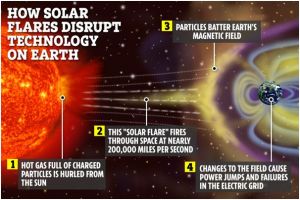

The author of this blog article is Dr. Rajesh V Chowdhary, Associate Professor, Department of Electronics & Telecommunication, International Institute of Information Technology, (I²IT), Pune (www.isquareit.edu.in) (rajeshv@isquareit.edu.in)
January 22, 2020
Many Space agencies across the globe have launched satellites in particular to observe and understand the changes happening on the surface of the sun. Many instruments specifically for measuring various parameters have been orbited through these space agencies. To understand the dynamics of Sun and the related activities and to derive the affects of these activities on our daily life is the main goal of research carried out by many space agencies & their mission. NASA has dedicated a centre named Space Weather Prediction Centre (SWPC) for maintaining a real time data centre for measuring certain parameters and predicting the occurrence of extreme events. A database of real time monitoring is being updated on their website for every 15minutes. A few agencies have dedicated their work to examine the effect of these solar activities on ‘Interplanetary Magnetic Field’ (IMF) and Geomagnetism of Earth.
Similarly, the Air Force Research Laboratory of USA has established Scintillation Network and Decision Aid (SCINDA), as a set-up of ground based stations that monitor trans-ionospheric signals at the UHF and L Band frequencies. The main purpose of SCINDA is to serve as regional specification and short term forecasts of scintillation occurring onto UHF and L Band frequencies i.e., especially on communication and navigation signals. These scintillations onto signals are caused due to irregular distribution of electron density across the equatorial ionosphere region.
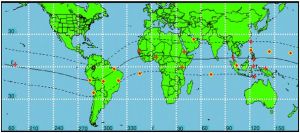

Image Courtesy : K Groves
The SCINDA station gives information of two eminent parameters namely, S4 (Scintillation Index) and TEC (Total Electron Content), which are the measures of how much signal has undergone modulation during transverse and total number of electrons present in a 1-m2 cross-sectional area between satellite and station respectively. S4 is indicated by values ranging from 0 to 1, where ‘0’ represents no modulation in the signal and ‘1’ being 100% modulated signal. ‘Scintillation’ word is characteristically referred to quick amplitude and phase variations in a received electromagnetic wave. The cause may be diffractive when electromagnetic waves are spread in an asymmetrical medium composed of several little changes in the refractive index. The variations in the intensity of the signal are deliberated by the scintillation intensity index S4. Due to solar activities it is obvious that our ionosphere will expand and become more ionized. Thus the solar activity occurrences and evidences can be correlated with SCINDA network data. Thus severe to extreme events impacts on to TEC and S4 can be realized using these stations data. Also, the diurnal, seasonal and annual variations of TEC can be studied for a specific geographic location by post processing SCINDA data.
GPS datasets can also be freely accessed at International GNSS Service Network
https://www.igscb.org/igs-stations
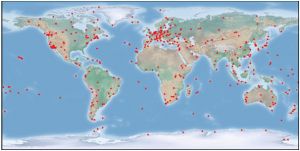

Image Courtesy : IGS
The author of this blog article is Dr. Rajesh V Chowdhary, Associate Professor, Department of Electronics & Telecommunication, International Institute of Information Technology, (I²IT), Pune (www.isquareit.edu.in) (rajeshv@isquareit.edu.in)
Recent Comments